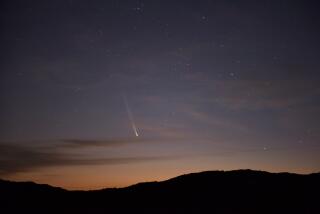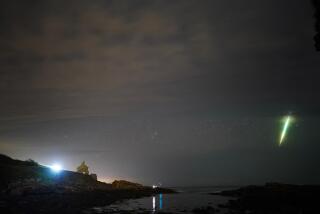Weather Drops Curtain on Halley Watchers’ Window
Millions of Southern Californians have spent the last week sitting in frustration beneath a blanket of clouds amid media reports that now is the best time to view Halley’s Comet.
Should the gray lid remain over the area for several more days, the opportunity to see the once-in-a-lifetime celestial celebrity will be lost until March.
The waning and late rising of the moon since Dec. 29 has opened a viewing window for amateur and professional comet-watchers alike. The first hour or two after dusk is the best time to catch the comet in the moonless sky before it dips below the horizon for the night.
Faintly visible to the naked eye, the comet currently is hanging in the southwestern sky about 20 degrees (or the width of two fists at arm’s length) above the horizon. It is near the so-called water jar in the constellation Aquarius and above the planet Jupiter, the brightest object in that portion of the sky.
Binoculars or a telescope will reveal the comet’s tail, which is actually light reflecting off steam leaving the icy body of the comet as it nears the sun at 98,400 m.p.h.
Clouds Mar the Act
Unfortunately, fog, clouds and spotty rain arrived with the favorable astronomic conditions as a high-pressure system that had kept Southern California clear and warm during Christmas week left the area.
A Jan. 15 deadline looms for Halley watching. On that date the comet will be blotted out by a bright rising moon. The brightness of the sun will keep the comet invisible during the month of February before it returns to the morning skies in March.
So, as the prime-time viewing days dwindle, the National Weather Service offered some hope for a break in the overcast being generated by a low-pressure zone over Baja California.
The government meteorologists predicted fairer--meaning clearer--weather by Monday and continuing Tuesday. They would not venture any further into the future, however, because “five days is about all we can do,” said weather service spokeswoman Pat Rowe.
She said she would love to be able to promise clear skies. “I’d like to see it myself.”
The Show Goes On
At Griffith Park Observatory, special events to mark the comet’s return after 76 years continue regardless of weather. Program Supervisor John Mosley concedes, however, “We’ve been anxious about (the clouds) for awhile.”
Despite the persistent grayness, some optimistic comet fans still make the trek up to the observatory. “We have people who want to look through the telescope even when it rains,” Mosley said.
A New Year’s Eve comet-watching fund-raiser for the observatory drew about 700 people who got everything but a look at the comet.
The clouds were still around Friday for the Passing the Torch event. Children were welcomed to watch planetarium shows, play comet-theme games and meet members of the Two-Timers Club, veterans of the last visit by Halley in 1910.
Linking Generations
“We’re trying to link the generations,” Mosley said. “These kids will be invited back in 76 years to see the comet with their grandchildren.”
Mosley said anyone who saw the comet in 1910 can join the Two-Timers Club by visiting the observatory and telling the staff.
The planning and expense of such events require that the show go on, clear skies or no. “We’re assuming it’s going to be beautiful,” Mosely said. “That’s all you can do.”
More to Read
Sign up for Essential California
The most important California stories and recommendations in your inbox every morning.
You may occasionally receive promotional content from the Los Angeles Times.










